Sofia
In the centre of the Balkans – sitting midway between the Black Sea and the Adriatic Sea – lies the Bulgarian capital of Sofia.
Population-wise, Sofia is the 14th largest city in the European Union, and is surrounded by a vista of mountainsides; with Vitosha to the south, Lyulin to the west and the Balkan Mountains standing tall in the north.
But while the city is surrounded by beauty, the centre itself – by looks – can be seen as rather rundown. With a real lack of charmingly designed buildings, Sofia can appear as a Brutalist cityscape.
But, looks can be deceiving, and there is so much more to the city than its exterior image. And even that is starting to change, with a lot of work taking place to revitalise the heart of Bulgaria making it a more vibrant metropolis to explore.
Yet, despite these improvements to its appearance starting to take shape, this capital city is still one that is overlooked far too readily by travellers; with many choosing to make their way to one of Bulgaria’s great ski resorts or to its stunning coastline instead. But by doing this, they are missing a rich tapestry of history with the modern blend of a youthful blossoming city.
Life in the area dates back thousands of years and extensive excavation work conducted during construction of the city’s metro system unveiled a treasure trove of Roman ruins from 2,000 years ago, when the city was called Serdica.
On top of that history, the Sofia of today is home to many of Bulgaria’s finest museums, galleries, restaurants and clubs. It’s now the countries hope that more people look at the city as a travel destination and that the work being done to revitalise its streets make many consider returning to it to explore further.
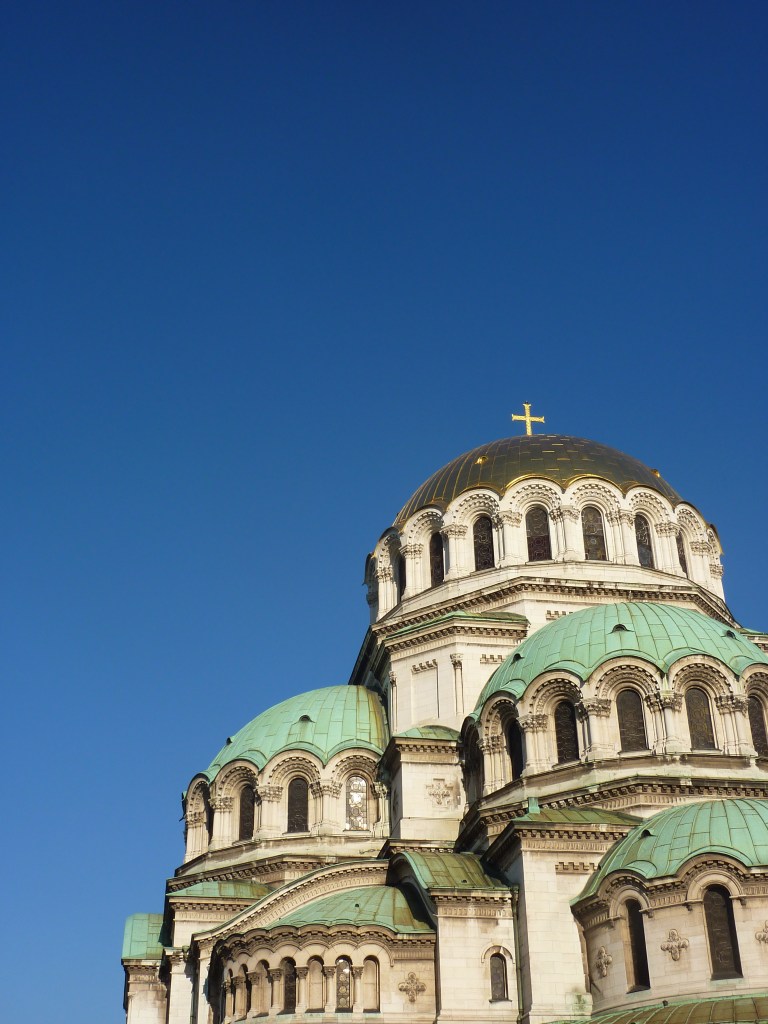
So what should a first-time traveller to Sofia know before embarking on a trip to Bulgaria?
Well the first thing to note is the weather.
Sofia’s climate is extremely changeable where winters can be relatively cold and snowy (average highs of 3°C) and summers can be hot and sunny (average highs of 28°C).
In summer, Sofia generally remains slightly cooler than other parts of Bulgaria, due to its higher altitude. However, the city is also subject to heat-waves with high temperatures reaching – or exceeding – 35°C on the hottest days; particularly in July and August.
My trip to Sofia took place in April time when the weather should hit around 15°C but happened to coincide with a mini heat-wave in the region. This meant that temperatures rose to over 20°C with midday temperatures feeling hotter than this due to minimal cloud coverage!
As someone with fair skin, I wasn’t expecting such strong sun at this time of year so went to a local shop to buy some sun lotion.
To my surprise, while everything else in Bulgaria appeared to be extremely affordable (more on this in a minute), sun cream and after sun were priced excessively costing far more than they would in the UK.
Now, I’m not sure if I was just unlucky with this and the few shops I looked in all knew they were locations that tourists frequent so upped their prices, or if this is something that happens everywhere. All I know is that the price for sun lotion did not match my closest expectations of the Bulgarian pricing structure. Not by a long way!
I never got to the bottom of this and always wondered why it could be. That said, my advice is simple. Take your own sun lotion and after sun with you and avoid buying when you arrive.
The next thing to think about is the currency.
Bulgaria is not on the Euro so you will need to use the local currency which is the Bulgarian lev.
At the time of writing the best rate I could see was 2.1947 Bulgarian lev to the Great British pound.
While that may not seem a lot, it’s worth remembering that – aside from the aforementioned sun lotion – Bulgaria is a very affordable country to visit.
In many cases items are at least half as expensive as they would be in the UK. As an example, an inexpensive meal that would cost around £15 in the UK is likely to cost as little as £7 in Sofia while a bottle of water costing £1.35 in the UK can cost as little as £0.62 in Bulgaria.
Beer is even more cost-effective many readers will be pleased to hear. A domestic beer costing around £5.70 in the UK will only set you back £1.27 in Sofia and an imported beer costing £5 in the UK will cost just £1.91.
These prices get even better the further out of the centre of the city you travel. During one day trip out of the city, we managed to buy two cappuccinos and a snack for a total price of around £1.50!
My advice here is to take as much money as you can afford to take with you and enjoy the time in the city. By doing so, you’ll easily be able to afford most things without having to continuously count the coins in your wallet as you go.
One difficulty travellers may experience is the language barrier.
According to the BBC, around 85% of the approximate 8.7m population of Bulgaria speak the official language; Bulgarian. On top of this, a further 2.5% speak Macedonian, which is considered in Bulgaria as a dialect of Bulgarian and not as a separate language.
Other minority languages include Romani, Turkish, spoken by 9% of the population, and the related languages of Gagauz, Tatar, and Albanian.
To make matters harder, they also use a Cyrillic script alphabet; making reading signs and menus that bit more challenging
That’s not to say life is impossible here for an English speaker as many Bulgarians have a grasp of the language even if they are not fluent.
As I may have mentioned before, languages are not my forte, and Bulgarian was never going to be on my to-do list. Yet I still think it’s important to make an effort when you’re in someone else’s country and just having a few words to hand does grease the wheels in your favour slightly.
Simple words like hello (Здравейте / Zdraveĭte), goodbye (Довиждане / Dovizhdane), thanks (Благодаря / Blagodarya) and please (Моля те / Molya te) can get you a long way.

Being aware of what type of plug adapters you need for Bulgaria is also important for all your electrical items. In Bulgaria there are two associated plug types, types C and F. Plug type C is the plug which has two round pins and plug type F is the plug which has two round pins with two earth clips on the side. Bulgaria operates on a 230V supply voltage and 50Hz.
A final thing to note is that Sofia is two hours ahead of the UK so, while you’ll lose a couple of hours when you arrive if you are travelling from Great Britain, you’ll gain them back on your return flight.
Getting there
Flying is the obvious way travellers can expect to get to Sofia (unless they fancy a rather long – albeit scenic – drive across Europe) with flights arriving at Sofia International Airport.
Situated around 10km outside of the city centre, the airport with its two terminals was welcoming around 7 million travellers through its doors pre-Covid-19.
Opened in 1937, the airport is now a major hub for many flight operators with numerous arriving from destinations within the UK including London Heathrow, London Gatwick, London Luton, Liverpool, Edinburgh and, seasonally, Birmingham, Manchester and Bristol.
Airlines flying in and out of the UK to Sofia include EasyJet, Ryanair, British Airways, Wizz Air and TUI Airways.
When I was looking to book this trip I actually split my flights from London Gatwick to Sofia between two different airlines as it proved cheaper that way.
On the way out I flew with EasyJet (for £129.98 total for two people) and returned with Ryanair (for £70.28 for two people). It’s worth noting that both these prices were pre-Covid-19 and included speedy boarding, and it’s highly likely prices have increased since then.
Flights with these budget airlines are what you’d expect. No thrills and lacking any real entertainment or comfort, but – for the short three hour flight – it’s bearable.

After arriving and getting through security, the other aspect of a travellers arrival that needs to be considered is how they get from the airport to the city centre.
Fortunately, there are a number of options available.
Firstly, a taxi can be caught from outside the terminal. It’s worth remembering to make sure you are getting into a licenced taxi. The official taxi operator from Sofia Airport is OK Supertrans, so only use these ones to avoid being ripped off.
To give you an idea, a taxi ride to the city centre of Sofia is approximately 17.60 Bulgarian lev and the journey duration is 25 minutes on average.
If you’d rather avoid a taxi, you can also opt for the metro to the city centre of Sofia. For this, just take metro line M2 to Serdika. A single metro ticket costs just 1.60 Bulgarian lev and it will take 26 minutes to reach the city centre.
If you prefer to travel by bus, there are two buses leaving the airport with direction to Sofia city. Buses 84 and 184 follow the same route and run every 30 minutes on average.
There is also the option of a private transfer which can be booked via Booking.com. This was the option we opted for despite it being a bit more expensive.
We met our driver once we were through the airport and he was waiting for us holding a sign with our names on it. He then took our luggage and led us to a private car, before driving us directly to our accommodation in the city centre. He also was the same driver who picked us up from our accommodation at the end of the trip and took us back to the airport.
This journey was quick and efficient and cost us £31 in total for the return journey and saw us arrive in good time to the city centre to start enjoying our trip.
Where to stay
While I could have opted for a nice hotel for an extremely affordable price, my love for quirky places won out – hence my stay at this great little AirBnB.
What this place lacks in size it makes up for in character.
Located on the top floor of a small apartment complex on ulitsa “Solunska” – right near the centre of the city – this charming AirBnB is deceiving.
I’ll be honest, the building itself – from the outside – leaves a lot to be desired but once you’re in and up at your floor, the style of the place wins out.
From the outside, you’ll notice the door to the building is around the back of the complex, in what can only be described as a bit of a waste ground.
Yet once you close the door to the outside and climb the stairs, you’ll be met by a rather splendid little place.

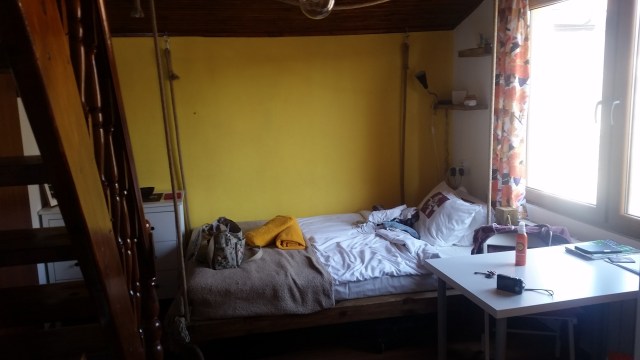


Opening the door, you’re straight into the living and sleeping area. The first thing you’ll see is the bed – which is a bit of a novelty as it is suspended from the ceiling by four large ropes attached to each corner.
To the right of the entrance a steep interior staircase takes you up to the ‘second floor’, while a small – but functional – kitchen and a shower / wet room make up the remaining part of the lower level.
A quick point to make is that the toilet is in this wet room and – as the name suggests – it gets very wet in here very quickly, so it’s best to keep any toilet roll in the main room, away from the shower when it’s on.
At the top of the stairs, on the upper level, you’ll be in a small storage space before being taken outside into a roof top terrace and balcony. This has been fitted with artificial lawn on the floor – and walls bizarrely – and is a great space to enjoy food and drinks while looking out over the local area.
This terrace area is a great part of this AirBnB and is somewhere I always enjoyed having a morning coffee and bit of breakfast.
One of the key selling points of this AirBnB is that it’s an extremely affordable base in a really central part of Sofia.
For my stay here I paid £98.28 in total for three nights – just £32.76 a night! So while it may not have huge amounts of space – for this price you can’t grumble too much.
And while that price was in a pre-Covid-19 world (which means, I would guess, that the cost has gone up a little bit) it’s unlikely to rival that of top hotels in the nearby area, making this the perfect spot to enjoy Bulgaria on a tight budget.
Getting around
Sofia is a fairly large city, but for me the best way to see it at minimal expense is by walking.
The city centre itself is pretty compact, so getting around on foot is pretty convenient.
Still travellers do have to remember one important thing when it comes to crossing the road at pedestrian crossings: don’t expect that drivers will automatically stop, just because you are standing at a pedestrian crossing, especially if it is not regulated by a traffic light. Always look in both directions, before you dare to cross if you plan to make it to the other side!


And while it is possible to join the numerous cars on the street by renting a car – which can then be used to explore outside of the city (this can also be done via organised tours – more on that latter – so don’t think that getting a car is the only way to explore further afield) – driving and parking in the city didn’t look too much fun from my experience.
So if your feet do get tired – or you have mobility issues – then an option is to use Sofia’s new metro system which is clean, efficient and cheap. There are several stops throughout the city centre, so you can use the metro as a quick way to jump a few extra blocks rather than walking. The metros are especially helpful if you want, or need, to visit the outlying areas of the city.
Top sites
As I’ve mentioned before one of the best ways, I find, to get to know a new city is to take part in a free walking tour.
For Sofia I used the superb Free Sofia Tour.
The Free Sofia Tour covers most of the main things to see in Sofia. From the Saint Alexander Nevski Cathedral (more on that site in a bit) to The National Theatre, it will immerse participants into the city’s rich history.
Taking part in this walking tour will mean you get cover a lot (if not all) the main sites in Sofia of the course of two hours before paying what you think the tour is worth at the end to the ever-helpful guides.
Tours take place everyday at 11am and 2pm and can be joined at a moment’s notice at the starting point in front of the Palace of Justice.
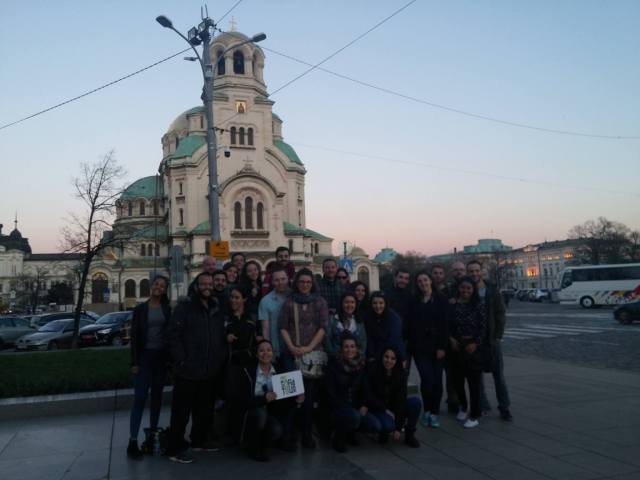
Should you not wish to take an organised tour and explore the city on your own, then a great place to start is one of the city’s primary tourist attractions; Cathedral Saint Alexandar Nevski.
Located a mere stone’s throw away from the city centre, this stunning cathedral has seen the city develop around it with it now sitting in the centre of a busy roundabout road-system.
With it’s dominating white walls keeping its green roof and golden domes aloft, the Cathedral Saint Alexandar Nevski has become a focal point and image of the city.
Built in Neo-Byzantine style, it is said to be one of the 50 largest Christian church buildings – by volume – in the world. If it was full, it should be able to host around 5,000 people behind its doors.
The construction of the Saint Alexander Nevski Cathedral started in 1882 but most of the work took place in the early 1900s. The cathedral was created in honour to the Russian soldiers who died during the Russo-Turkish War of 1877-1878, when Bulgaria was liberated from Ottoman rule.
Today, the cathedral still operates with many Bulgarians attending services here. And despite still being active, visitors are also able to get entry to the inside to marvel at its splendid décor, stunningly painted walls and its blue and gold laden ceilings.
There is no entrance fee, but photos are strictly prohibited inside.



A mere kilometre walk back into the centre of the city, travellers taking a stroll down one of the city’s main streets – bul. Todor Alexandrov – will be welcomed to the heart of Sofia by the imposing presence of the Saint Sofia Monument; also known as the Statue of Saint Sofia.
Designed by the local sculptor George Chapkanov, the 24m statue is the newest in the city – after been erected in 2000 – having replaced the statue of Vladimir Lenin that was once on the same spot.
The statue works as the perfect example of the old meeting the new in the city. Standing on a column in the middle of a busy crossroad, the statue’s golden face looks out upon the Batemberg square, where TZUM – The Central Department Store – the presidency and the Government houses are situated, while also being within touching distance to some of the historic finds unveiled during the metro construction works.
So while it’s fair to say that Saint Alexandar Nevski Cathedral is seen world-wide as the image of Sofia, for Bulgarians the statue of Saint Sofia is certainly the city’s symbol.
As this is situated on the street, there is no fee to view this attraction.
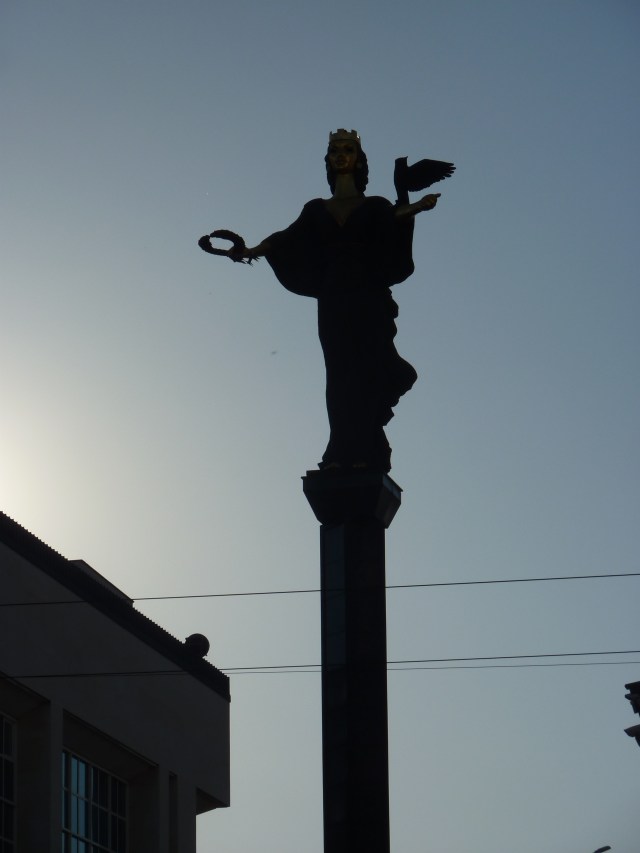
Nearby, situated within a stone’s throw of the statue, are a number of Sofia’s other key sites in an area known as The Largo.
This part of the city is made up of three main buildings designed and built in the 1950s with the intention of becoming the city’s representative centre.
In this area, visitors will see the Bulgarian National assembly – also known as Party House as it was previously used as headquarters for the Bulgarian Communist Party – the TZUM department store, the Council of Ministers, the Presidency, the Sofia Hotel Balkan and the Ministry of Education.
Perhaps the most architecturally stunning of these is the visually impressive – albeit slightly oppressive-looking – Party House; which was built between 1948 and 1954.
When it was first erected it was adorned with The Red Star – a typical addition to Soviet-style buildings – which has since been removed with the fall of communism in Bulgaria.
As mentioned, this mighty building with its towering columns was once the headquarters of the Central Committee of the Bulgarian Communist Party, and – for a year between 2020 and 2021 – was used again as the National Assembly of the Republic of Bulgaria.
However, following the April 2021 Bulgarian parliamentary election, the National Assembly moved again to the old Parliament House – situated less than a kilometre away on bul. Tsar Osvoboditel – because the new opposition led-majority viewed the Party House building as a symbol of Bulgaria’s communist past.
These buildings are mainly for observing from the outside, so unless you have official business you’re unlikely to need – or be able to – gain entrance to them. So once again this is a free attraction.
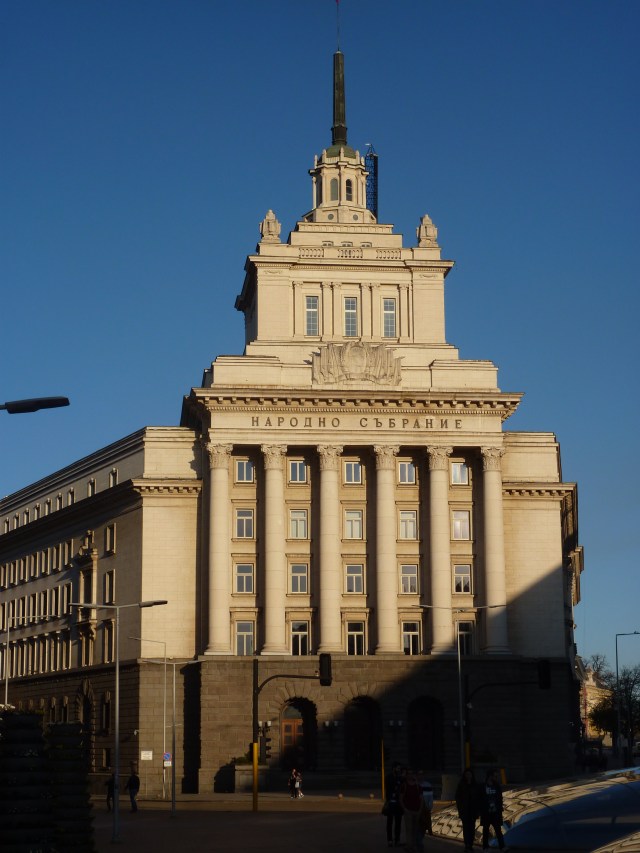
Also located outside of the National Assembly sits the mighty Tsar Osvoboditel Statue: erected in honour of Russian Emperor Alexander II who liberated Bulgaria from Ottoman rule.
Resting on a stone pedestal, this black granite statue depicts the Tsar sitting atop his noble steed looking towards the Assembly building as if he is keeping an eye on the country’s affairs.
Nearby, in front of the aforementioned TZUM department store, sits a small example of the beauty of the old city radiating through the Soviet-era doldrums. For here, visitors will find the Church of Sveta Petka.
This medieval Bulgarian Orthodox church is a small one-nave building partially dug into the ground. It features a semi-cylindrical vault, a hemispherical apse, and a crypt discovered during excavations after the Second World War.
Dating back to the 11th Century, it is today a monument of culture for Bulgarians and is known for its mural paintings from the 14th, 15th, 17th and 19th Centuries depicting numerous biblical scenes.
Also in the same area – situated in a courtyard between the Sheraton Hotel and the Presidency (part of The Largo) – tourists will find the Church St. George Rotunda.
Surrounded by Soviet architecture, this red-brick structure was built in the 4th Century as a Roman baths. It was transformed into a church during the Roman and Byzantine Empires and is widely considered to be the oldest building in modern Sofia.
This church doesn’t sit alone and is part of a larger archaeological complex. Included here are ancient ruins, a section of a Roman street with preserved drainage, foundations of a large basilica, a public building, and some smaller buildings making it a truly intriguing ancient site to behold.

As is the case in many modern cities, Sofia is home to more than one religion. Aside from the numerous churches that adorn its streets there are also several stunningly impressive mosques celebrating Muslim culture throughout the city. One of these that should be visited is that of Banya Bashi Mosque situated in the heart of the city alongside Banski Square.
The mosque was designed by the famous Ottoman architect Mimar Sinan and completed in 1566, during the years the Ottomans had control of the city.
With its 15m diameter dome, Banya Bashi Mosque’s was actually built over natural thermal spas meaning that visitors can see the steam rising from vents in the ground near the mosque’s walls.
And, just a street or two away from this site, you can also sample the spring water itself thanks to new constructions that tap the water to the surface allowing people to drink or take mineral water home; free of charge. It’s worth noting, however, that this water is warm and has a slightly sulphurous smell to it; so, it is unlikely to totally quench your thirst on a sweltering day in the city or make you want to come back for more!
Visitors who wish to go inside the mosque can do so for free.
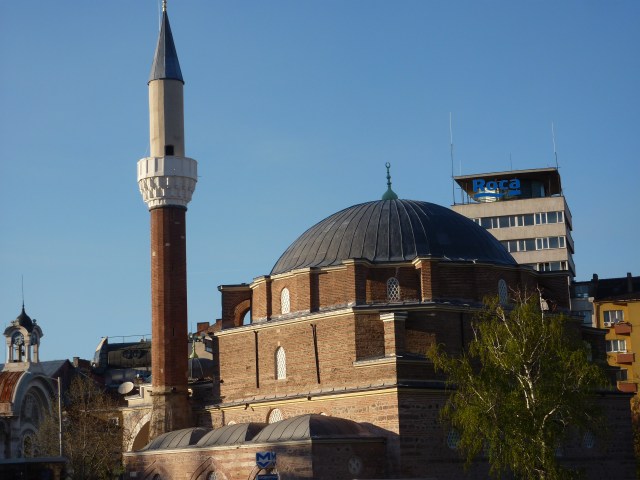
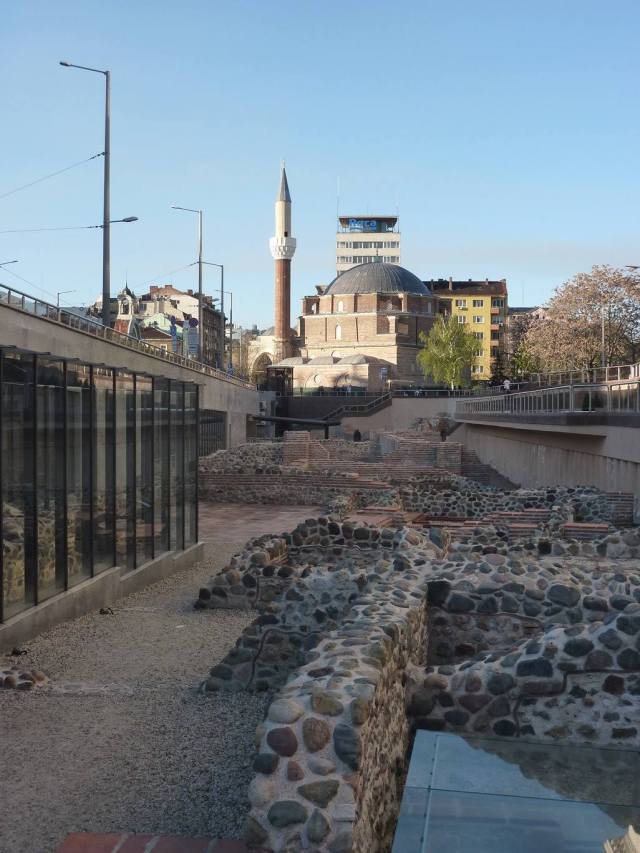
While Russia may not be a firm favourite for many people right now, their influence over massive swathes of eastern Europe cannot be ignored.
Sofia is no different and has felt the impression of Russia over the generations with many reminders remaining in the city today. One such example is that of the Russian Church Sveti Nikolay Mirlikiiski (again there is no entrance fee to go inside here).
The church is built on the site of the Saray Mosque, which was destroyed in 1882, after the liberation of Bulgaria by Russia from the Ottoman Empire. It’s a fact that you’ll find apparent in much of Sofia. Many religious sites like this one have swapped faiths on a regular basis over the centuries as the dominant religion of the time takes control.
This church is unmistakably Russian. Its tall towers with its golden domes lofted above the green roof make it a dominating sight.
Built in 1907 – and consecrated in 1914 – the church remained open after the Russian Revolution and during the Communist regime in Bulgaria (1944–1989); though priests and church-goers were carefully watched by the State Security police.
While the outside remains vibrant and colourful, the inside has been darkened by years of smoke from the candles that burn day-after-day. The site also houses the remains of Saint Archbishop Seraphim beneath its main floor. The grave of the archbishop – who died in 1950 – is a place that local people visit to pray, and leave notes, asking for wishes to be granted.

While this article focuses primarily on things to do in Sofia, it’s worth noting that there is much more to Bulgaria than the confines of the capital city. Travellers – who are looking to get out of the capital for at least a day – won’t go far wrong with a trip east to the beautiful, cultural capital of Bulgaria; Plovdiv – one of the oldest continuously inhabited towns in Europe.
A two-hour drive will get you from the capital to Plovdiv, situated on the two banks of the Maritsa River. For those who don’t want to hire a car and brave the – somewhat erratic – Bulgarian road system, then numerous tour companies take busloads of day-trippers to and from Sofia.
For our trip we used the fantastic Traventuria who take guests twice a week (Wednesdays and Sundays) on a full day-trip to Plovdiv and Koprivshtitsa with pick-ups from outside the aforementioned Alexander Nevski Cathedral for as little as €45 per person.
With our guide we were able to see all the top sites of interest during a two and a half hour guided walking tour of the Old Town and the centre of Plovdiv before venturing to Koprivshtitsa in the afternoon – the must-see town nested in the mountains.
Unlike Sofia, Plovdiv gives a different aspect of Bulgarian life. Away from the hustle and bustle of the busy capital, Plovdiv offers a more relaxed and charming lifestyle to those who call it home.
Historically, the city was developed on seven syenite hills with evidence of the habitation in this city dating back as far as the 6th millennium BCE.
Today, the city is a treasure-trove of history which is now carefully – and seamlessly – blended with the modern day.
A walk around the cobbled-streets of the city’s Old Town will showcase some of this quaint city’s history while must stops include that of the Hisar Kapia – or medieval gate – as well as the Roman Theatre of Philippopolis; constructed around the 1st Century AD.
Marble seats create a semi-circle around the stage, while tall columns – some three stories high – frame the magnificent mountainous backdrop.
While it has been around for the best part of 2,000 years, the theatre was only rediscovered again in the 1970s following a landslide. Serious excavation and restoration programmes would follow to bring the theatre to its current day splendour.
With a belly-full of history, the nearby new town – with its wealth of shops and restaurants – is worth a walkthrough before heading back to your mode of transport and making the swift drive back to Sofia.
The drive back to Sofia will give visitors time to reflect on their Bulgarian experiences. For anyone who’s witnessed these sites and this country first-hand, it remains surprising that Bulgaria is yet to really make a name for itself as a go-to tourist destination despite all it has to offer and affordable prices when you arrive.
Having said that, it is getting more popular. Therefore, travellers considering a vacation to the Balkans should do so sooner, rather than later, in order to enjoy the welcoming and hospitable locals – and their country – before it becomes too crowded to be able to do so.





Where to avoid
As with many city’s it’s always best to keep a good tab on where your belongings are at any given time.
Bulgaria isn’t the richest of places, so the number of opportunistic thieves praying on tourists may be greater than in some other cities. That being said, I didn’t come across any during my stay and had no issues with any of the local people.
So this is more about how best to spend your time in Bulgaria rather than areas that are dangerous to go to. Listed here, therefore, are some locations that you’d not lose out too much on if you were short of time.
The first of these is the National Palace of Culture.
As Bulgaria further invests in its future by making full use of its past, it’s clear that, sitting alongside Sofia’s wealth of religion and rich history is its blossoming cultural presence. At the centre of this is the city’s National Palace of Culture.
This huge multifunctional conference and exhibition centre is the largest of its kind in south-eastern Europe and is a celebration of Bulgarian life. Beautifully presented, the centre is set in welcoming, yet spacious, surroundings where visitors can potentially enjoy a host of activities including concerts, operas, and ballets.
While this area is impressive to see, travellers only really need to visit here if they have a tickets to see such a show.
A second suggestion is that of the Law Court Building; also known as the Palace of Justice. While this is a fine reminder of Bulgarian’s thirst for justice – with its impressive lion statues guarding its entrances – it offers very little beyond saying you’ve seen it.
Chances are if you took part in a walking tour of the city – or even just spent any time in the city centre – then you’ll have passed this building without even noticing it.
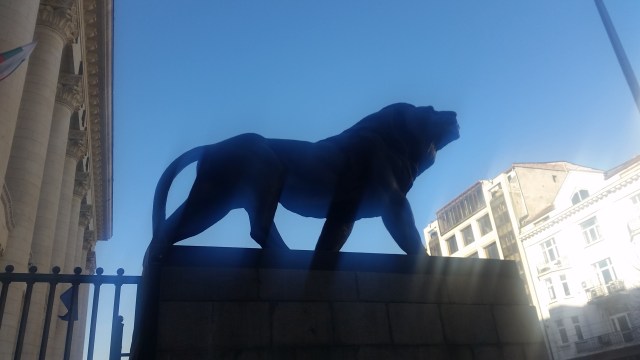
Great places to eat
For those looking for a quick stop for a snack or a coffee, I have two great finds for you.
The first is Confetti Oborishte and this spot – located at ul. “Graf Ignatiev” 4 – is a wonderful spot to grab some gelato.
Served in big portions – this ice cream shop will make you want to keep coming back with its wide range of flavours to try at affordable prices.

The second option is the Social Cafe Bar & Kitchen restaurant.
While you can get main-meals in this centrally located establishment (bul. “Vitosha” 16), it’s the hot drinks and milkshakes that made me want to keep coming back.
This welcoming café has a wide selection of drinks on offer but their milkshakes are extremely satisfying. With generous portions of ice-cream on top of thick shakes, these drinks really help cool you down on a hot day in the city.

As with all major cities there are a wealth of great bars and restaurants to explore but one that I particularly took to during my stay in Sofia was the Indian Taj Mahal Restaurant.
This delightful restaurant sits just back off the narrow – yet busy – ti avgust street; situated a few roads away from the Cathedral Saint Alexandar Nevski.
The peach exterior walls and the tiled restaurant name will let you know you’ve found the right place. Upon entry, you’ll either be guided to a seat on the lower floor, or – ideally – ask to be taken to one of the upper two floors where the interior décor is a delight.
The menu is extensive and caters to all tastes with a wide range of curry dishes – at a variety of spice levels – to choose from.
Traditional tandoori dishes make for a great meal and portions are both well presented and plentiful. You will not leave this restaurant hungry!
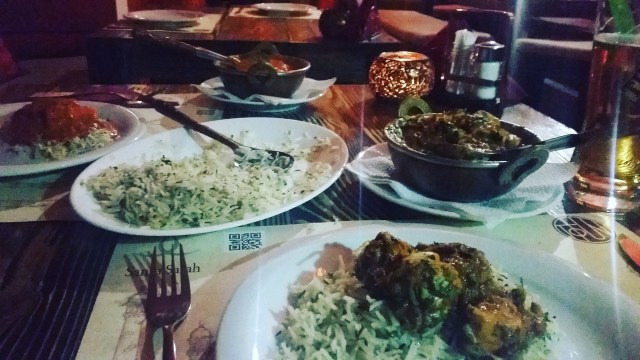
If you are like me, then you also won’t want to miss out of the the array of naan breads on offer.
Best of all – as with a lot of Sofia – the meal will be inexpensive leaving you feeling both full in your stomach while also not empty in your wallet.
Sit back and enjoy the curry, along with a glass or two of beer, and bask in the vibrant feel that this restaurant – and indeed Sofia in general – has given you during a stay in one of Eastern Europe’s up-and-coming go-to cities.
Useful links
Cathedral Saint Alexandar Nevski
Russian Church Sveti Nikolay Mirlikiiski
Social Cafe Bar & Kitchen restaurant
Remember you can follow World Complete on Twitter, Instagram, Pintrest, Tumblr and Facebook send your comments and pictures from your travels using #WorldComplete and #Travel.

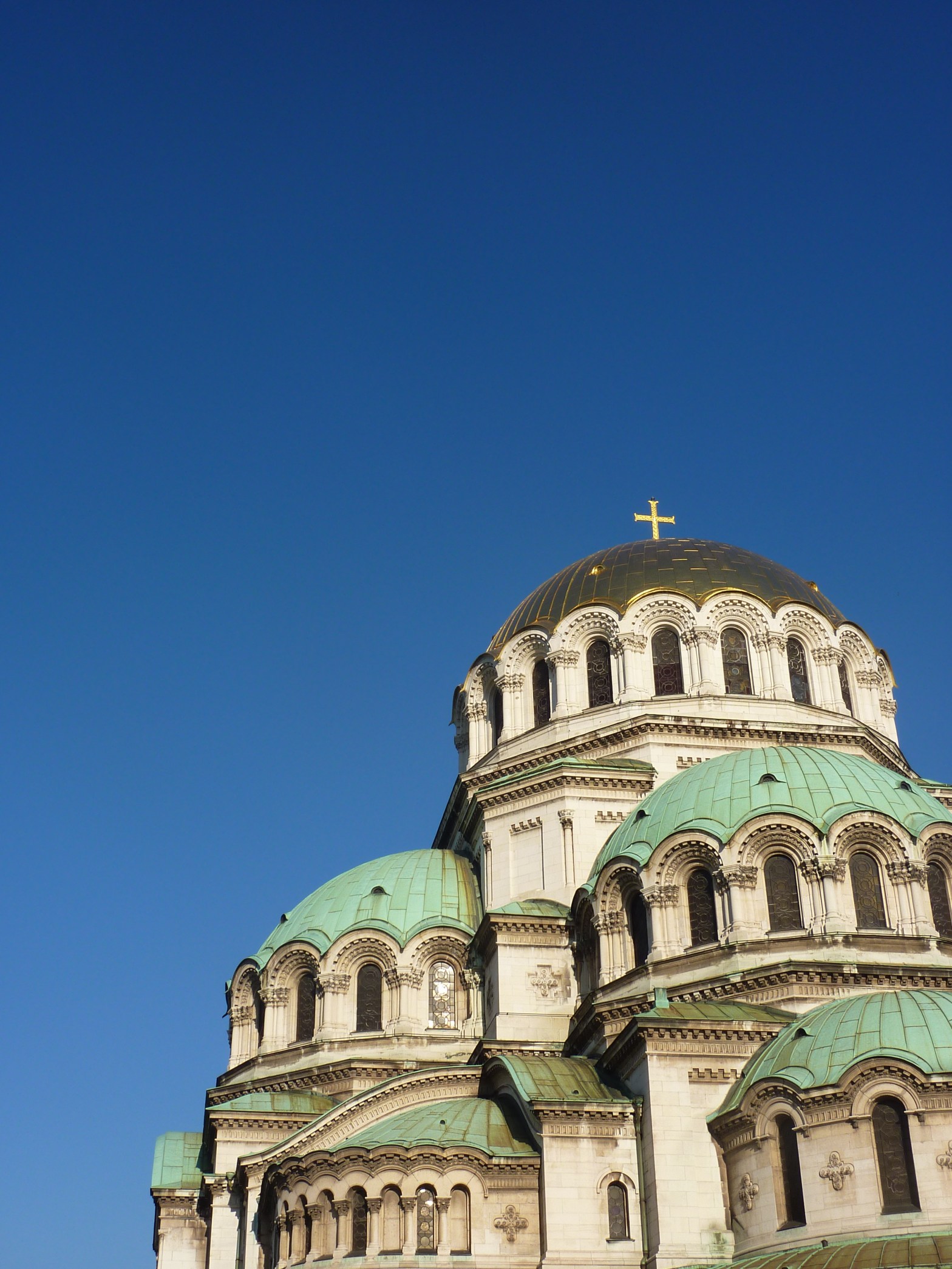
Sofia looks and sounds like it would be a wonderful place to spend some time just wandering about and enjoying what’s on offer. Thanks for sharing!
LikeLiked by 1 person
It really is. Thanks for stopping by 😀
LikeLike
Very timely post as we’re heading there next month. For me it’s a return visit – I was there in 2019 and took a liking to the city. My husband hasn’t been before but I have a feeling he’ll like it too 🙂 Incidentally when I was there in 2019 it was permitted to take photos in the cathedral but you had to pay an extra fee – well worth it I thought.
LikeLiked by 1 person
I’m very envious of your trip. Hope you both enjoy it. Thanks for stopping by my blog post too. Hope it was useful for you. 😀👍
LikeLiked by 1 person
Sofia, Bulgaria, has definitely shed its communist identity and has become an underappreciated city in Eastern Europe. We have seen the pictures and heard about its history, and Sofia continues to fascinate us. We will definitely endorse checking out this oft-overlooked European city. Thank you for sharing!
LikeLiked by 1 person
Thanks so much for stopping by. Glad you enjoyed the blog!
LikeLiked by 1 person
You’re welcome, and we did. It was great!
LikeLiked by 1 person
Great post! Unfortunately I have never visited it!
LikeLiked by 1 person
Thank you so much for the kind comment.
LikeLiked by 1 person
🙏🌹🙏
LikeLiked by 1 person
Sofia is a great city. We have a friend who lived there for a few months and enjoyed it.
LikeLiked by 1 person
Thanks so much for stopping by 🙂
LikeLike